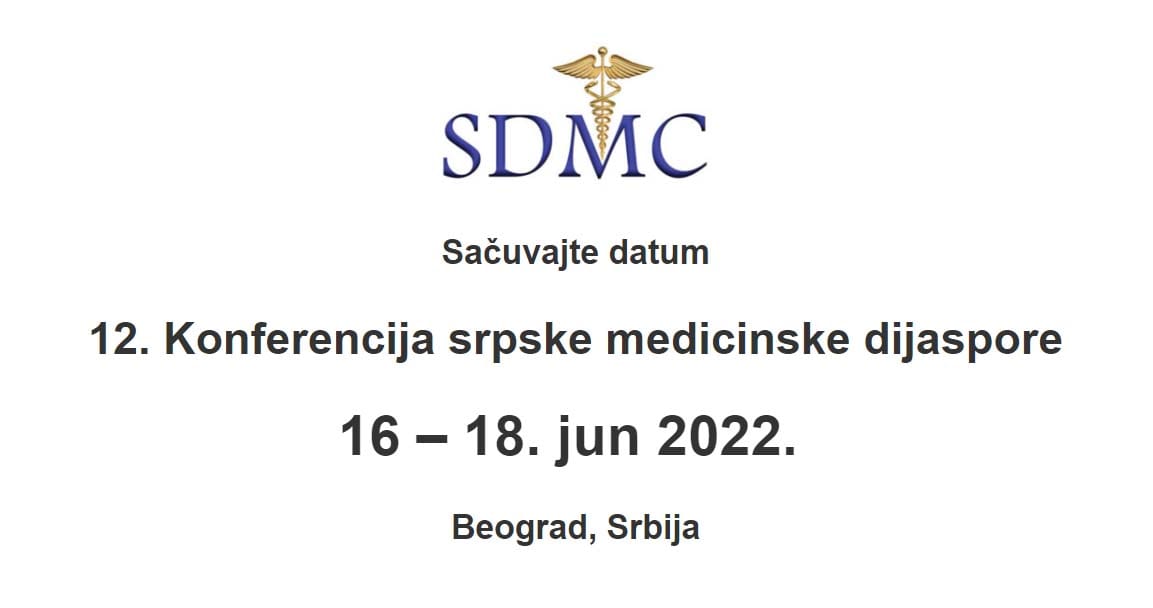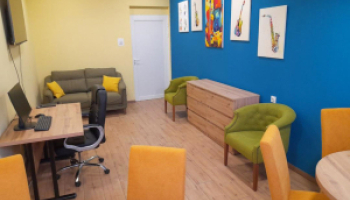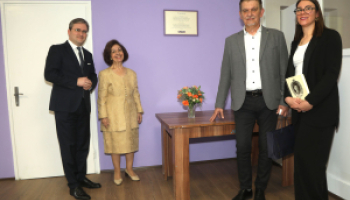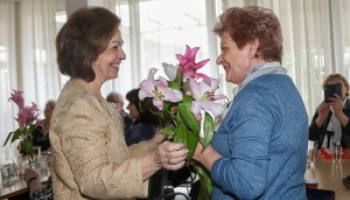- Home
- News & Events
- DR ZORAN IVANOVIC INTERVIEW FOR POLITIKA – A SMALL PART OF EXPERIMENTAL THERAPIES IS BECOMING THE STANDARD IN MEDICINE
DR ZORAN IVANOVIC INTERVIEW FOR POLITIKA – A SMALL PART OF EXPERIMENTAL THERAPIES IS BECOMING THE STANDARD IN MEDICINE
27 Jun 2022

Prof. Dr. Zoran Ivanovic, physiologist, interview for “Politika”
A small part of experimental therapies is becoming the standard in medicine
In an exclusive interview for “Politika”, Prof. Dr. Zoran Ivanovic spoke about the achievements and experiences as medical professional, but also about the importance of the Serbian Diaspora Medical Conference, that is organized under the patronage of HRH Crown prince Alexander and Crown Princess Katherine. The interview was prepared by the journalist of “Politika”, Mrs. Daniela Davivov Kesar, to whom we thank this time as well.
The text, which was published in the printed edition and on the website of “Politika” is also available below:
Doctor of Medical Sciences Zoran Ivanovic, physiologist and cell biologist, head of the Department of Research and Development in the field of cell engineering and scientific director of the French Blood Institute for the region of New Aquitaine, is one of our greatest experts on stem cell therapy. For “Politika”, he reveals how far he has come with the use of these cells in medicine.
You are one of the top experts in the use of stem cells in treatment. What diseases can they help with?
I am researching stem cell biology, conceiving and developing new therapeutic approaches based on stem cells. It is all very connected, which can be seen in the example of some of our results. Fundamental research has led us to understand the need to activate in the stem cell the “feeling” of being exposed to low concentrations of oxygen in order to self-renew. From this, an approach to stem cell proliferation was conceived, which enabled their more efficient use during transplantation. In practical medicine, only approaches based on hematopoietic stem cells (for the treatment of leukemia, aplastic anemia, immunodeficiency syndromes, regeneration of accidentally destroyed bone marrow…) are routinely used, while in other disciplines the use of stem cells is still in the experimental phase and clinical studies.
What are the experiences in their application in regenerative medicine?
The use of stem cells today has been developed in hematology, where the re-establishment of the hematopoietic system can also be considered regeneration. There are also procedures used in sports medicine, mainly for the treatment of damage to cartilage, tendons, bone tissue and muscles. However, in this case, they are mainly related to cell and tissue engineering and transplantation of mature cells, which is cell therapy but not stem cell therapy. Mesenchymal stromal cells, also called mesenchymal stem cells, are also used. There are real stem cells present in very small numbers, and most of the cell mass is actually fibroblasts at various stages of maturity. Therefore, the effect of these cells is not directly regenerative. This may result in anti-inflammatory, immunosuppressive or indirect regenerative effects. That’s why I don’t consider mesenchymal stromal cell therapies as “stem cell therapies”. As for approaches based on other stem cells, they are in experimental phases: most approaches are at the level of experiments on animal models and some are at the level of clinical trials in humans. It is very important to understand that the problem is not solved when something proves effective on an animal model. Not only does it need to be confirmed in humans, but in order to do so there are obstacles that are biological, commercial, ethical and even political in nature. Only a few experimental therapies end up as standard in routine medicine.
Can stem cells cure diabetes, autism or cancer? There is a lot of public controversy about that…
Insulin-dependent (type 1) diabetes mellitus is being attempted to be treated with cell therapy in several directions. Mature cells of the Langerhans’ pancreatic islets (secrete insulin) that originate from another human being (cadaveric cells) and are transplanted into the pancreas, or from an animal (pig) encapsulated in special “ampoules” that leak insulin. In both cases, the effects are limited in time, because despite immunosuppressive therapy, these cells are eventually inactivated due to the immune rejection reaction. With regard to stem cell-based therapies, embryonic stem cells and induced stem cells are being experimented with. In both cases, there are serious obstacles. If up to one of these cells does not differentiate, in vivo they give tumors-teratomas. In addition, there are obstacles of an ethical nature with embryonic cells. There is clinical evidence that allogeneic hematopoietic stem cell transplantation (mainly from placental blood) can improve conditions in autism, and clinical essays are being conducted to that effect. It is similar with mesenchymal stromal cells. Stem cell cancer treatment begins with hematopetic transplants (leukemias, lymphomas, myelomas…), and recently the treatment of other cancers (cancer and sarcoma) with other somatic cells: neuronal stem cells and again mesenchymal stromal cells. This is quite complex.
Are there opportunities to make organs out of them in laboratories?
As far as I know, incredible results have been achieved in this area. I read somewhere that at this moment from stem cells in the laboratory we can “grow” organs or tissues organized into functional units: heart, liver, brain, muscle, bone, skin… Development of technology of the concept of “mold”, and then the bioprinter promises a lot.
You are one of the most quoted Serbian scientists. How important is this for your work and research?
For me, quoting is important in terms of understanding how other authors interpret our results and how our results fit into certain hypotheses to which they relate. Also, the context of citations may indicate the importance of these results for a given area. As for the number of citations, index “x” and other bibliometric indicators, I personally am not interested in them at all and I consult them only when bureaucratic structures ask me to indicate them in a form, moreover, I believe that the way of their application in the evaluation of scientific work’s quality is absurd and reflects negatively on the scientific process. For example, if you publish something from an area that deals with two million people, whatever it is, will be quoted more than if you publish from an area where only a hundred people work on the entire planet. Then, if your publication presents results that are ahead of their time only a small number of people or even no one will understand their importance, so they will not be cited. Either they will fall into oblivion or they will start being quoted years later.
You were also the youngest member of the SLD Academy of Medical Sciences and the youngest scientific advisor in the history of Serbia. Why did you continue your career abroad?
I was really elected as the youngest both to the title of scientific advisor and to the Academy of Medical Sciences SLD. And that’s a curiosity. As for my career, I simply followed my scientific project and looked to go where it was possible to continue it. When I started the project in Florence, where I was in postdoctoral training with a scholarship from the European Association for Cancer Research, further continuation of the project required serious technical conditions and financial resources. Coincidentally, the laboratory was visited by a colleague from France, who led a team at the Medical Faculty in Limoges and who suggested that I continue the project with him, which I accepted. And so began my “French career” with a scholarship from the French Association of the ARC, then with contracts with professors of hematology at the Universities of Limoges and later Bordeaux, and finally in 2002 with the appointment of scientific director of the French Blood Institute for Aquitaine and Limousin, (the region expanded in 2016 and became New Aquitaine), when I got the opportunity to form my own team, which reached a critical mass in 2005 and 2006 and is constantly evolving. My family followed me everywhere.
You are participating in the Serbian Diaspora Medical Conference. How important is your connection and cooperation with colleagues from Serbia?
This is my second time participating in the Diaspora Medical Conference organized by the Crown Princess Katherine Foundation. This is a great idea because it provides an opportunity to get to know our people who are “scattered” around the world. In that sense, this Conference is unique and very important. It is, of course, an opportunity to meet colleagues from Serbia. I must emphasize that I do not neglect contacts, so I respond as much as possible to the invitation of our professional and scientific associations. I would like to emphasize the cooperation with the Medical Chamber of Belgrade, where I have been regularly participating in their gatherings for several years now, thanks to my colleagues Dr. Ninoslava Mihailovic and professors Olga Popovic and Dejan Nesic.
Danijela Davidov Kesar





